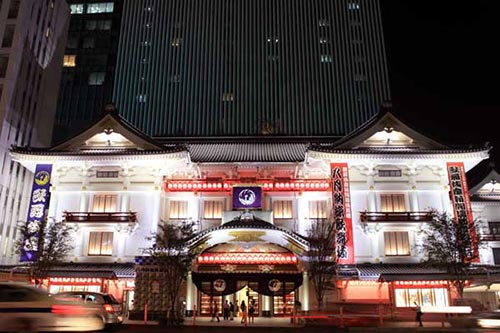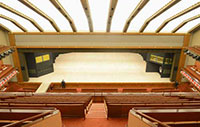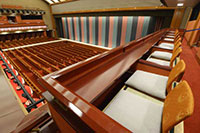Web Japan > Trends in Japan > Pop Culture > Kabuki-za has many fantastic attraction
KABUKI-ZA HAS MANY FANTASTIC ATTRACTION
Midair Stunts, Revolving Stage, and Runway

The Kabuki-za opened its doors on April 2, 2013. There are three variations of the nighttime illumination according to the season. The photo is of the summertime pure white illumination.
In the spring of 2013, the new Kabuki-za opened its doors in Japan's capital, Tokyo. This representative kabuki-only theater has been revived with an entire renewal, which was conducted for the fourth time since it was founded 124 years ago. While significantly leaving the vestiges of the theater in the past, such as the large tiled roof that curves smoothly, the theater has been wonderfully modernized by incorporating new technologies for interiors and exteriors as well as stage equipment, with a high rise building linked to the establishment. Its figure is as if exactly embodying the spirit of kabuki, which has striven toward new things and thrived while carrying on the approximately 400-year long tradition.
Edo's Punk Rock!

Picture titled Shibai Oohanjou no Zu by Toyokuni Utagawa the First, depicting the image of a theater back in 1817 when kabuki was Edo's leading entertainment. (National Theatre of JAPAN possession)
Enlarge photoThe roots of kabuki is said to be the kabuki odori (kabuki dance) that was staged in Kyoto in 1603. The stage made up of simply choreographed play and dance, centering on eccentric performances like women wearing male costumes and singing popular songs, can be likened to Japanese punk rock in modern parlance. Then, by the late Edo period (1603-1868), kabuki established a style of performing arts that combines music, dance and acting. Up to this day, kabuki has continued to produce numerous great actors and masterpieces, including human-interest plays and period pieces created based on historical facts and incidents, out-of-this-world stories that fuse the past and present as well as gorgeous dances.
It was also in the Edo period that the tradition, in which only male actors perform, took hold. In the Western world during Shakespeare's time, there is an example of a boy actor playing a woman's role, but it is a rare case that only male actors play all the female roles—called onnagata—from young daughters to aged women, as seen in kabuki. The appearance of the female roles wearing a gorgeous costume and dancing splendidly was admired by women back then, and the theater became the source of cutting-edge fashion in areas like hair and outfit design.
Moreover, it is none other than the Kabuki-za that has continuously protected and fostered the essence of this traditional culture, transitioning the hall of entertainment that has intoxicated the people of Edo from a small stage to a luxurious theater.
On-the-Day Viewing of Single Act
The new Kabuki-za, which was rebuilt from a vacant lot for the first time in 90 years, features delicate measures like barrier-free construction while reproducing the main design of the previous theater.
The atrium lobby (called oma) invites visitors to a dramatic and out-of-the-ordinary space with a gorgeous scarlet carpet. The three-floored theater has 1,808 seats. Since there is an English version audio guide with earphones, it is also possible to listen to the commentary on important lines as well as particular renderings while watching the play. The fourth floor Viewing of Single Act is a theater space that is unique to the Kabuki-za, offering on-the-day viewing of an act where you can select your favorite performance for an affordable price. Its capacity is 156 people, including standing viewers, so you can enjoy a play even if you just casually visit on the day.
Inviting Visitors to a Different Dimension

There are many great spectacles to see - female impersonators (onnagata) with graceful gestures more feminine than real women; performances with midair stunts (chunori) where actors soar above the audience; and the hero (benkei), the most popular role in the Kabuki repertoire, daringly dashing off the hanamichi runway.
Enlarge photoIf you are seeing kabuki for the first time, you will undoubtedly be surprised by the assured quality of the polished art such as by the kata (type) of the acting and dance that actors have inherited from their ancestors. In addition, you will notice that technologies and stage productions that have become the norm in modern theater, such as devices for Midair Stunts where characters like heroes or someone with magical powers are lifted with a wired rope above viewer seats—almost like the musical Peter Pan—have originated from kabuki.
Another device is the Revolving Stage where the stage switches to a different scene decorated on the other side by making the floorboard that is cut in a circle rotate 180 degrees. Not only does the revolving stage facilitate a speedy change of scenes, it is a production that transcends time and space by switching from inside the house to outside the house or from the sea to the coast, making scenes look three-dimensional, and showing two events alternately. It is said that kabuki adopted this technology for the first time in the world in mid-18th century.
The hanamichi runway, which is a passage starting from the left side of the stage from the audience's perspective and runs through the viewer's seats, is another theater structure unique to kabuki. The runway is interpreted as different places like a mountain path or the sea depending on the scene, and it is a space where actors say their lines or strike a pose that is characteristic of kabuki. Even the viewer's seats become part of the stage, unwittingly drawing the audience into the world of the story.
Indeed, the stage produced by a variety of such devices is a fantastic and extraordinary spatial dimension. The spirit of the producers and actors to continue to study every day to bring joy to the audience will unfailingly be felt from every corner of the theater.
Photography with Costume and Make-up

From a kabuki that is watched, to a kabuki that is experienced—at the photo studio on the fifth floor of the new Kabuki-za Tower, visitors can dress up like kabuki actors and take a commemorative photo. The duration of the course, which includes full make-up, is around 3-4 hours. The studio also rents out the kimono for people who wish to watch a play while wearing the kimono © Studio Alice Co., Ltd.
Enlarge photoThe renovated Kabuki-za has a wealth of attractions not only as a theater but also as a tourist facility, including its comprehensive ancillary facilities. On the fifth floor of the 29-floor high-rise Kabuki Tower that is linked to the establishment, there is a Kabuki Gallery where exhibitions are held every season with costumes and props displayed in the exhibition space. There is also a photo studio on the same floor, where a commemorative photo can be taken wearing kabuki costume and authentic make-up. In the open space newly established underground of the theater, there are many stores standing side by side, selling souvenirs that can only be purchased at the Kabuki-za, bento (boxed lunch) that can be had between theater showings, and various kinds of sweets, attracting a bustling crowd of visitors and tourists every day.
The gorgeously reborn Kabuki-za is like a heart-throbbing treasure box packed with excitement and surprise.
(September 2013)
- Sengoku Busho Now the Rage (March 2012)



